| Andreas Weiland
The Sculptures of the Canadian
West Coast-based Artist Marion Lea Jamieson
What touches me immediately is the beauty of The
Singer – the awareness of the (female, I feel) body that it incorporates
and expresses. Expressing it because it is the body that expresses what
we have come to call conventionally “the soul.” “Body awareness” – is it
possible to coin that term which would translate, in fact, the German word
Koerperbewusstsein – a dialectical term, because it implies a dual perspective:
“We” (via our consciousness) are aware of our body,
“I” (thus my
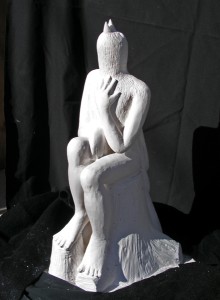
Marion Lea Jamieson, The Singer
(side view), Febr. 2011, 50cm h x 30 cm wide x 30 cm deep (Plaster
model for a larger work in concrete or bronze. Final work to be 2.25 m
high x 1.35 m wider x 1.35m deep)
consciousness) is aware,
of my body, of my bodily, corporeal existence. The other side of the coin,
the opposite perpective so to speak, is that “the body is aware” or “expresses”
my psychic situation, my history, my way of thinking and feeling and –
in one word – “being.” My “soul,” so to speak. And this also
most authentically (and this means perhaps, in the least falsified way,
a way that is not pretentious) when I'm not aware of it, consciously. “The
Singer” seems to come close to such intimacy – a moment where the soul
is revealed, and where the body gives itself to us, the Others, as that
innocence which is authentic.
The bracketing of consciousness, and thus the temptation
to “pretend” and to “display” and to “pose” (and thus to create an
auto-image for one's self, and to suggest an image of one's self to others)
– this bracketing, and therefore the refusal of and avoidance of the typical
temptation of our era is accomplished in this work. To me, it seems, that
the hidden face – hidden, as if under a soft, woolen cap, or an ancient
Egyptian accessoire of enigmatic rites – symbolizes the sleep of consciousness,
the baring of the soul in an uncontrolled, unmanipulated state. The tiny
upper end of the cap, almost like a small crown, emphasizes the enigmatic
character of the moment caught. The hand, of the left arm, partly covering
the breast(s), protects – , it protects, I feel, the integrity of the “self.”
The movement, the gesture implied, is the gesture that points inward, touching
– or covering, partly – the heart.The German language knows the saying,
“Hand aufs Herz” – (put your) “hand on (your) heart.” Which is like asking
somebody, though lightly and in friendship, not in court, “Swear that this
is true.” The movement, thus, seems to me to confirm the authenticity of
the moment, the authenticity of the body/soul that is expressing itself
and that is expressed at this moment. The fact that the breasts are partly
covert by the same movement of the left arm and hand, accentuates this
tender, protective and yet declaring self-expression. The same is true
of the position of the legs – tenderly close to each other, affirming body
consciousness, one knee raised slightly higher than the other – which makes
the posture no longer defensive. This presence of the “singer” reveals
the opposite of “extrovertedness”(extroversion) - but neither does it signify
introversion; it rather speaks of a soft, vulnerable presence, a presence
that rests securely in itself, and in this moment of acute awareness
of being. Now we may comprehend why this is “The Singer”: this body so
aware and so present sings the song of its existence.
The work is also an act of resistance because it incorporates
a tender, humane, “female” view of the female body – nor a voyeurist view.
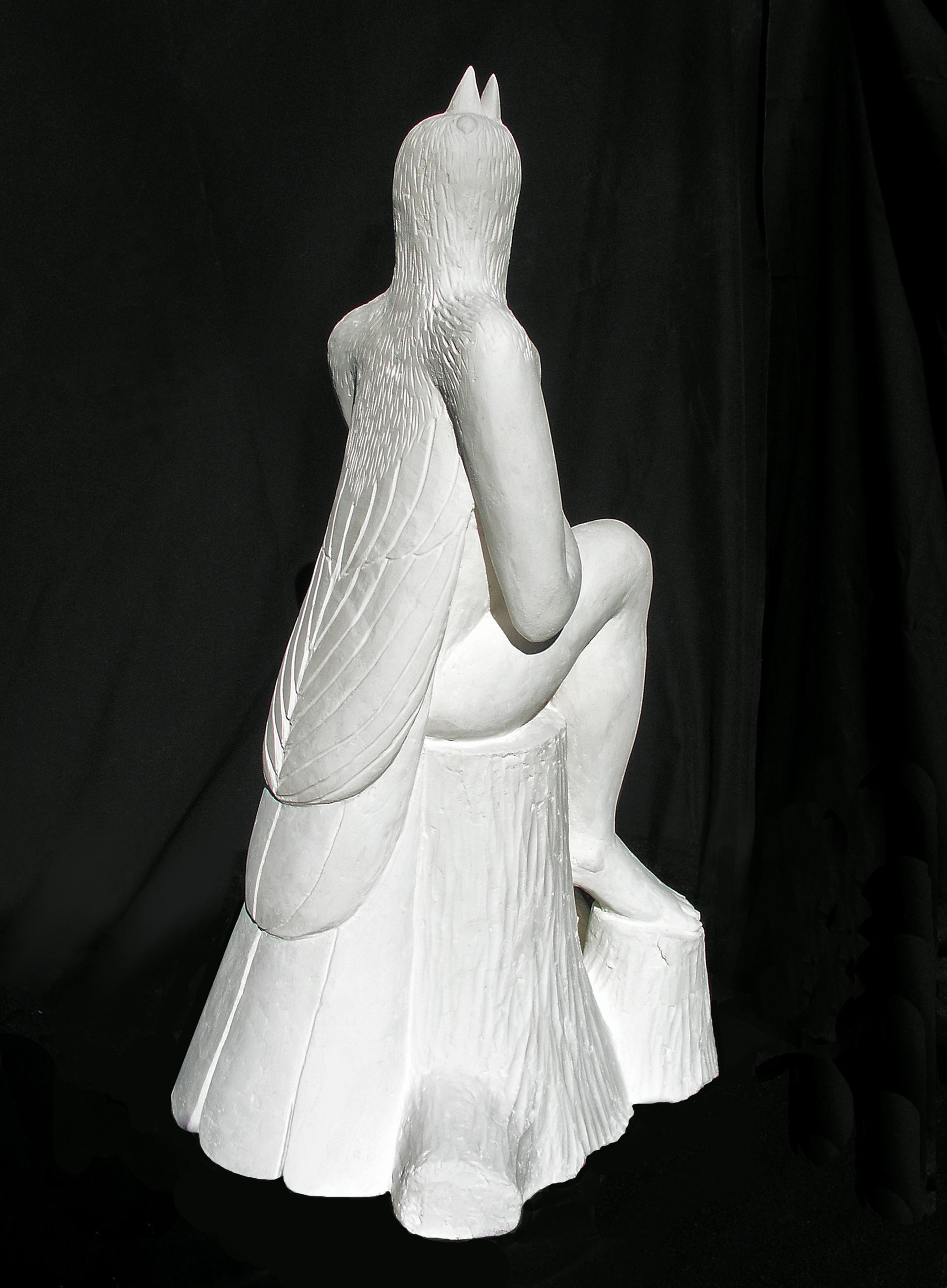
Marion Lea Jamieson, The Singer (rear view)
Exposing myself to the rear view of this sculpture, I
discover a new aspect: The Singer is a bird. I think of Haidaa myths and
other tales of North America's First Nations. The sculptor is close to
that part of the human heritage. Subconsciously or not, she reveals something
– a wish. In a myth, the girl turns into a bird, a birdwoman, as
soft feathers grow on her back. "She never felt as warm and protected."
For Marion Lea Jamieson, birds are singers. And she sings with her sculpture,
The Singer. A soft tune; living harmony of existence that
rests in itself, so securely.
The Austrian sculptor Alfred Hrdlicka once suggested that
every sculpture is the testimony and outcome of an elementary, physical
act of uncovering, of laying bare, both the figure that emerges from the
stone, and the “existential way of being” particular to the creator of
that figure. Perhaps we should not interpret this statement too narrowly
– which I think he would not have wished us to do, either. Sculptures are
no self-revelations, but transcend the given and owe so much to the imagination,
to our vision of the world, our longing and the pre-conscious urge to express
it. Just as poems and novels should not be read as “merely autobiographical
documents,” sculptures – and paintings – are far from being just that,
merely mirrors of the artist. And still something of the essence of the
artist who creates is present in his creation. Her or his attitude and
position towards the world, towards nature, fellowmen, society? Perhaps.
Hrdlicka, conscious of how abstract art was pushed in
the late 1940s and in the 50s, both by the International Committee of the
Museum of Modern Art, by American tycoons like the Rockefellers, by the
Dept. of State in Washington, later on by USIS, saw this as a concerted
campaign against realist art (and literature) which had achieved what Gramsci
would have called cultural hegemony during the late 1920s and early '30s
in Europe and had become a vital force also in the US, in China, Japan,
and “Latin” America. Invitations extended to artists, Congresses and symposiums
sponsored, exhibitions made possible thanks to abundant funds made available
by US sponsors turned the tables and gave abstract expressionist art an
exposure in the media and a successful presence in museums and the art
market that was denied to socially critical realist artists.
I think this view is not entirely unfounded; even though
other factors come into play if the achievement of abstract artists is
recognized. But the weight of the material economic and political factors
that put realist art on the defensive and in the end almost marginalized
it for several decades must not be underestimated.
Hrdlicka accused abstract art of one thing mainly – of
“eliminating the human being in art.” He likened this effect of abstract
art to the result a neutron bomb would produce in the real world: it leaves
the object world, above all, the technostructure, intact but eliminates
man.
If we look at much abstract art we see that indeed, as
subject matter – as immediately recognizable subject matter – man is usually
missing. Human emotions may be expressed, but not man, present in a situation.
If I turn to sculptures of Marion-Lea Jamieson, it is
also because – rather than elimating man – they often confront us with
man; with woman/man – with the human existence. And this in an immediate
way, or in a way that is different from the immediacy that lays bare the
“spiritual” in an abstract painting.
Yes, the spiritual can also be laid bare in a “realist”
sculptures. Take Anima I for example.
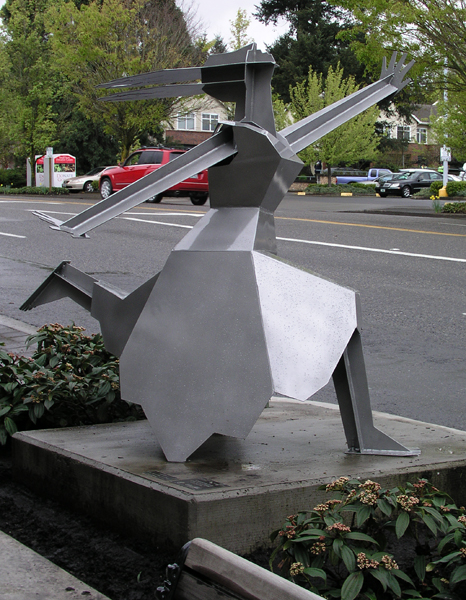
Marion Lea Jamieson, Anima I (July 20099,
68" h x 66" w x 68"d, mild steel with urethane clear coat, shown on exhibition
in Lake Oswego, Oregon.
Both the exhibited sculpture, placed in public space,
and the maquette reveal a strong expressiveness of the woman we are shown.
The influence of Zadkine's expressionist Cubist realism cannot be excluded,
regardless of any conscious receptive process that may have taken place
or not.
This aesthetic and ethical approach shares were little,
perhaps nothing with Hredlicka's existential vitalism. It refuses Hrdlicka's
elementary appropriation of human flesh, which has something very raw,
sexually aggressive and thus macho-like to it. It also refuses the cold
despair and the weight of history that resound in the cry uttered by Zadkine's
Rotterdam sculpture, or the growth-like, yes plant-like expressive forms
that characterize his “Tree of Life” (L'arbre de la vie (1957)) or
the flame(s) transported by his “Prometheus” (1954).
There is something light-hearted to this moment of movement
captured by the sculpture. It is the spirit of a girl or young woman who
runs, full of longing to discover a world.
It is as if she is going to fly, the next second. Jubilant
like a bird. Anima – not necessarily referring us to C.G. Jung here – is
the soul, and it is female. The forms of the body – abstracted. Because
it is not the flesh, now – it is that spirit which makes her
run: eager and jubilant because of the freedom to be herself, and to discover.
Marion Lea Jamieson said, in one of her texts that I found
on her website that as a Modernist, engaging in abstract painting, she
refuses to denounce politically, socially committed realist art – or the
idea that art should turn a blind eye to the “real world” (of which art
is, of course, a part, like we ourselves are a part of it).
My experience was the other way round. What I loved was
committed realist cinema. Rossellini, Vertov, Straub, Godard, Chris Marker,
Mizoguchi.
And yet I befriended filmmakers that created poetic,
seemingly a-political works.
O I agree with Hrdlicka. With Bert Brecht. I feel close
to and I think and hope that I am solidary with all those who say that
it matters to be committed today, because we live in an era in which the
Latin saying Homo hominis lupus, man is a wolf for his fellowman, gains
such a modern, topical meaning. And therefore we should take sides and
work for a better, freer, more democratic, more just society. And today,
more so than ever, also for the protection of the material basis of our
existence, the protection of nature, of this vulnerable planet.
And yet, and yet... When Hrdlicka says that modern
abstract art eliminated man, and glorified that aura of a new “technofascism”,
an overpowering presence of the technologically produced world around us
(that is mirrored by the big bureaucracies of the new Leviathan), I know
that although this is confirmed by works like Stéphane Couturier's
Usine
Alstrom, Belfort, photo 3, halle transport” (2009) or Thomas Florschutz's
untitled (palace) 33 (2006/08) and perhaps even by American
painters of the 1930s and '40s given to almost constructivist depictions
of 'industrial cityscapes', I still love works like Charles Demuth's My
Egypt, or certain works by Sheeler that turned to the world of
industry, depicting the beauty of modernist building like the Rouge River
Ford Plant - but eliminating man.
When in Taiwan, on my way from Tamshui to Taipei in the
late afternoon, for conversations with an artist friend or with other
artists, I often saw the girls leaving the electronics factories (the Philco
plant, for instance) after a ten or twelve hour shift – and could see the
fatigue, and I thought of Demuth's painting, My Egypt. It
captured such moments, even though the human figure was absent.
Whereas many art critics in the U.S. interpret the focus
of painters like Sheeler and Demuth on industrial architecture as an exuberant
expression of American optimism, I see a sadness inscribed in Demuth's
painting just referred to. These art critics relate the title to the synchronous
discovery of ancient Egyptian art, thus to the pride taken in the megalomania
of Egypt's pharaos. I relate the title My Egypt to the experience
of the people Moses leads out of Egypt. “My Egypt” is a synonym for "my
prison, my desperation, my oppression" – and for its dialectical opposite:
"my longing to be freed." In Taiwan, in 1976 or 1977, I wrote a poem about
those girls leaving the plant, referring to Demuth, and speaking of them
as leaving their Egypt, every afternoon. – In other words, the painting,
for me is about humans, the human beings hid behind the walls of the building.
The people working at the machines. About the need to change life, and
the world. Changer la vie, changer le monde. The surrealists
reminded us of it. As a student, I wrote it on posters I glued on the walls
of the Dept. of German and the Dept. of Sociology. Because it was still
so valid...
The next work I will focus on here, titled Continuum
by Marion Lea Jamison, is also "abstract" - in a way like Demuth's
My
Egypt painting, in its preferrence for abstract, geometric
forms.
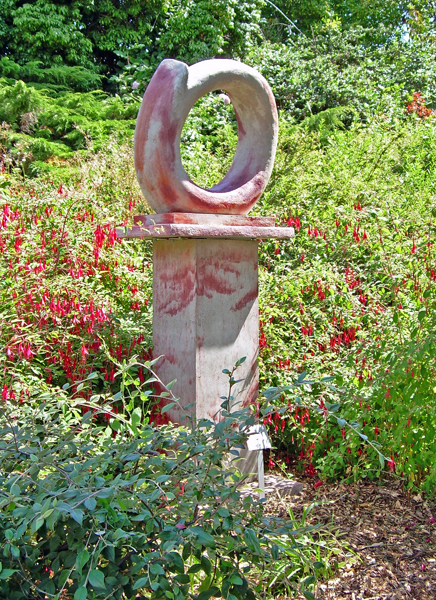
Marion Lea Jamieson, Continuum
The tendency to abstract could already be felt in many
avant-garde works close to the Constructivism I always liked, and in works
of artists belonging to the Futurist movement, like Marinetti who became
so closely associated with Italian Fascism (which I dislike).
I rediscover my ambivalence.
I say, yes, basically Hrdlicka makes a valid point. And
yet I liked the poetry of Rodchenko's spiraling Radio Tower, I loved quite
a few works of Moholy-Nagy that are plainly abstract constructivist and
that banish man as subject matter. Is is so strange that I like Marion
Lea's abstract sculptures, too?
The form here is organic. Perhaps
it is far more plausible to call it concrete than abstract - for
it shows us an organic form close to forms found in nature.
Like a wave, almost, the top part of this work, the central
part that attracts our attention, appears to me. Yes, the part that rests
on a support integrated, in terms of material, dimension, color into the
art work. The support provides the contrast: the static element that carries
- and gives a space to - the appearing movement. A concretization, a frozen
moment of a wave that, rising high, comes full circle. O no, I am wrong
– it has none of the force, the violence, of the ocean. This formed object
does not allude to the surf, the wave that can smash things. This is peaceful.
It is movement, and yet, it rests “in itself.” Hrdlicka would have like
the organic form. So do I. It is not a polished, industrially made surface.
It is hand-made. Arp comes to mind. But Arp's world was smoother,
it was whiter, it was male. The red traces left by the artist's, Marion's
hands, are echoed by the colors of the blossoms around the spot where the
sculpture has been placed. Who can deny that it becomes a part of nature?
“Conundrum 2” reminded me of a woman. Her essential body,
in movement. An abstraction thereof, it is true. She seems to stand and
turn, slightly, at the same time. Her essence is dual, protecting
and open. Protecting someting inside (her child? her integrity?),
thus shielding it from outside aggression... And yet, at the same time,
opening. Baring much of her innermost soul.
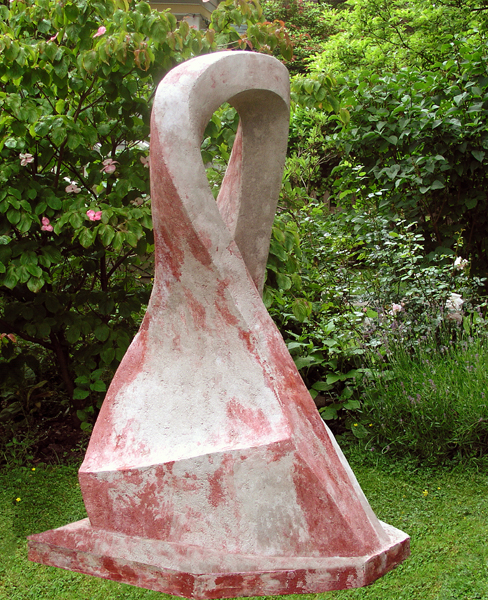
Marion Lea Jamieson, Conundrum II
The soul is the form of the body, Aristotle wrote. If
this sculpted form is, in its abstracted way that has been chosen, the
form of a human being, it also reveals the soul.
Yes, it is possible to be an agnostic, perhaps an atheist,
and still be aware of it. The soul. Don't touch, don't hurt it – the inner
voice says. Your own, or the other one's. It feels the scars, just like
the flesh feels them. Strange, the whitish and faintly red color reminds
me also of the color of flesh.
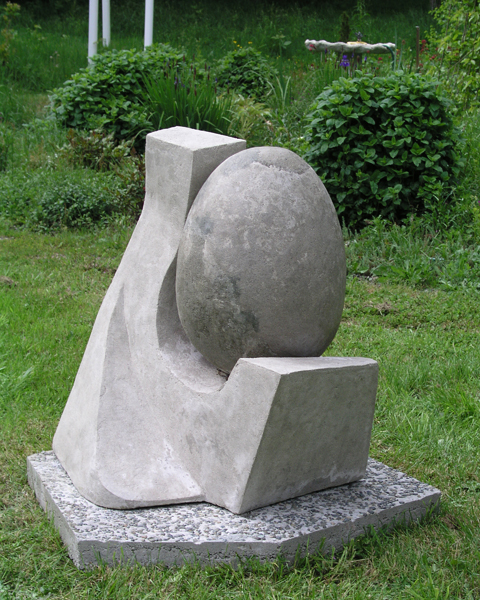
Marion Lea Jamieson, Still Life, March 2003, concrete& pigments,
3.5' high x 3' wide x 3' deep
Do we humans crave peace? Harmony? A balance attained?
This “still-life” is still like a living being that rests, like water that
is not stirred now, it is quiet, it is serene – and yet it is life. Life
that has attained a moment where everything is in balance, a situation
where we are secure. Is the child, thus, secure before it leaves – before
we leave – the womb? Is the egg-shaped form held here, securely,
that oviform secret I spoke about, referring to it in a poem, and referring
also to a poem by Ron Loewinson, in the 1960s? The form is held, it rests,
it is left in peace. And yet, above it, there is that wide opening, wide
as the sky, the realm of possibilities, the realm of visions, of freedom.
When the moment arrives, we can choose – the security of the nest, and
the risk of freedom.
Who says that abstract works banish the human being from
the world of art? Perhaps they need not even banish the struggle for emanicipation
– that emancipation of mankind which Hrdlicka and Brecht, among many others,
had at heart.
I am glad that I could see Marion Lea Jamieson's work.
Some of it, I know. Maybe more, soon.
|
Subsequent note by AW on "The Singer"
When I wrote this small text (in the form of an email to Marion Lea
Jamieson), I had not yet seen the following image that reveals feathers
or a feathery gown and that allows us to read what I took for a cap as
the beak of a bird.

Marion Lea Jamieson, The Singer (rear view)
This tends to turn the figure indeed into the representation of a birdwoman.
Does it also turn it into an androgynous being? I sympathize with Ivan
Illich's position in this regard who analyzed a "depolarization" which
can "lead to an ideas of unisex and the present intellectual fashion" to
embrace and give heightened attention to "androgyneity."
(Ivan Illich, Gender, NY 1982, German edition: Genus. Reinbek 1983,
p.239, note 107)
What I think is important is Marion Lea Jamieson's reference to folk
myths. She hints at the Egyptian precedence of images that humanize birds
or turn humans into birds (or in fact do both, simultaneously), as in the
case of the horus bird.
But one does not have to evoke the Egyptian versions of images alluding
to this myth (even though she encountered them in the Louvre).
For it is clear to me that, consciously or preconsciously, this West
Coast based Canadian artist is close to the myths of the indigenous population
of her region, when she evokes the myth of the birdwoman.
An Aleut legend of the "Princess Raven" tells us about the transformation
of the human princess into a bird: "[...] A small hemlock needle
slowly fell towards the water. When it floated down to her, princess picked
it up and swallowed it. She waited, but nothing happened. Then she felt
a jerk in her back. The princess reached back to see what the pain was
and to her surprise, she felt feathers, a wing grew out of her back
and wrapped around her. It was so warm. The princess felt a love like never
before." Yes, feathers grow on her back. It protects. She feels so warm
now.
A Haida legend, "How Raven Brought Light to the World" also uses the
symbol (or metaphor?) of swallowing a needle. In this case, the needle
is quiet obviously a penis symbol: About the human girl we are told
that "[...]she swallowed the needle. It slipped and slithered down into
her warm belly, where the Raven transformed himself again, this time into
a tiny human. After sleeping and growing there for a very long time, at
last the Raven emerged into the world once more, this time as a human infant."
In a Cherokee legend, "The Owl Gets Married," an owl transforms into
a man.
It is interesting how intimately this Canadian artists is apparently
rooted in a very deep-reaching sense in her regions socio-culture (which
includes the heritage of the Haida and other First Nations).
In a text published on her blog, entitled “On
Birds,” Marion Lea Jamieson writes,
The Singer [...], Febr. 2011, 50cm h
x 30 cm wide x 30 cm deep.
Plaster model for a larger work in concrete or
bronze. Final work to be 2.25 m high x 1.35 m wider x 1.35m deep.
“The sculpture I’m currently working on is a realistic
depiction of a half-bird/half/human figure with its head thrown back singing.
The Singer celebrates the human instinct to make music and to create art.
Biologists usually explains the singing of birds as a way of defining territory
but it is difficult not to interpret bird-song as springing from the same
impulse as human-song and The Singer is transported by the uplifting power
of singing.
The work considers how we are different and how
we are the same as birds but it suggests that the similarities are greater
than the differences. It refers to the myths of every culture in which
birds & humans transform into each other. It is part of a series
of sculptures using as a theme archetypal images of part human/part animal
figures that I have been creating for some time. These figures are characteristic
of myths in every culture in the world and create a recognizable common
thread among cultural traditions. Human/animal myths originated at
a time when humans were more highly attuned to other species and all cultures
include stories about animals that take on human characteristics to pierce
the human/animal divide. My sculptures attempt to reconnect with and communicate
the wisdom of ancestors who understood the inter-relatedness and inter-dependence
of all forms of life and that sustainability involves protecting the ecosystems
on which we all depend. This sculpture explores inter-connections
between humans and bird species. Previous civilizations understood that
birds & humans are interdependent, and if we destroy bird habitat,
we destroy ourselves. The sculpture was inspired by a small, four-thousand
year-old terracotta piece I saw in the Louvre Museum in Paris.
Ancient Human/Bird Myths
I am interested in the human/animal fusion images
in that they stem from an earlier period of human development when people
regarded the natural world as benign. The earth and its many &
diverse forms of life were seen as benevolent [by human beings] as long
as they stayed in tune with its forces. In earlier religions the
animal or animal-headed gods/goddesses are symbolic expressions of a deep
spiritual understanding. For instance, when an animal was depicted in Ancient
Egypt, it represented a particular function/attribute in its purest form.
When an animal-headed figure is depicted, it conveys that particular function/attribute
in the human being.
In addition to understanding the inherent connection
and identification with other forms of life, earlier forms of religion
recognized the importance of a balance between male & female energies.
J. J. Bachofen (1861) postulated that the historical
patriarchates were a comparatively recent development, having replaced
an earlier state of primeval matriarchy, and postulated a matriarchal society
and chthonic mystery cults as the second of four stages of the historical
development of religion. The first stage he characterized as a paleolithic
hunter-and-gatherer society practicing a polyamorous and communistic lifestyle.
The second stage is a matriarchal “lunar” stage of agriculture with an
early form of Demeter the dominant deity. This was followed by a stage
of emerging patriarchy, finally succeeded by the stage of patriarchy and
the appearance of civilization in classical antiquity. In the later Abrahamic
monotheistic religions, God is the Father, dominant, powerful, fatherly
& masculine. This theory has its adherents and detractors, but it is
a compelling and useful idea to explain the imbalances & conflicts
between natural/human and male/female in current societies.
Many believe the anthropocentrism of the Abrahamic
monotheistic religions is the underlying reason why humanity dominates
and sees the need to “develop” most of the Earth for human habitat at the
expense of all other species. The Book of Genesis states, “ And God said,
Let us make man in our image, after our likeness: and let them have dominion
over the fish of the sea, and over the fowl of the air, and over the cattle,
and over all the earth, and over every creeping thing that creepeth upon
the earth.” This belief that human beings have special status in nature
based on unique capacities provides the rationale for unlimited human expansion
and resource use on a finite planet. That is why I am interested in looking
at earlier concepts of the relationship between humans and the natural
world to understand how, as artists, we can re-brand the human species
in a more earth-friendly format.”
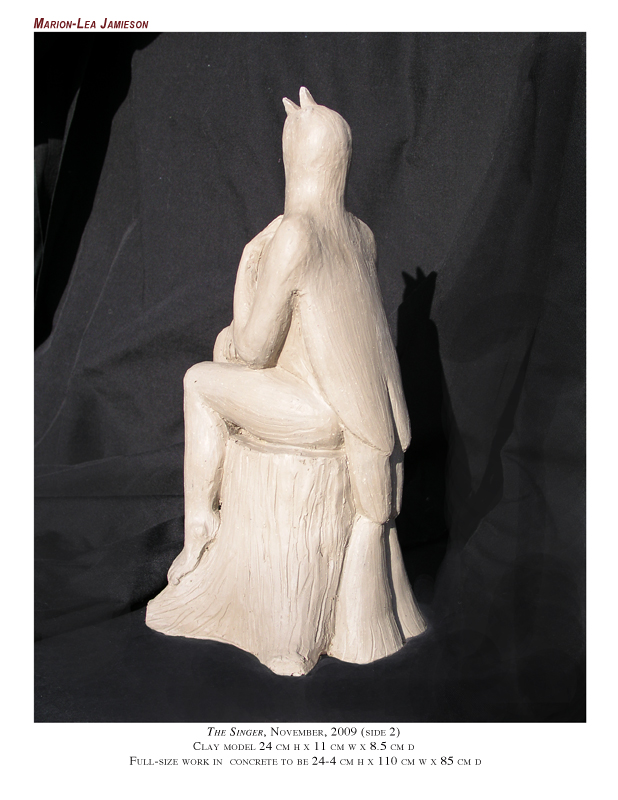
The Singer, Clay Model, Nov.
2004
[Marion Lea Jamieson to AW:]
“[...] It is so interesting to get another's
view on one's work - to see it with another pair of eyes. However,
your interpretation of the Singer is skewed by the fact that sculpture
is a 3D mode & a one dimensional poor quality internet image does not
give enough information. In fact, the Singer's head is thrown back
& what you thought was a cap is a bird's beak. I have attached
another view that may make it more clear.
As you can see from the rear view, The Singer
is half-human/half bird. This speaks to your comment that,
"We are just one species, just an element in
the bigger context of this earth we inhabit. And our solidarity must extend
to all species, to every child, woman and man, wherever they are. At least
this is what I feel about it. Who cares whether this is still good art
criticism, or perhaps no art criticism at all."
This human/animal theme is one I have been pursuing
since the 1980's, and expresses what I feel is at the heart of all tragedy
in the human condition - our bifurcation of existence into opposing camps,
the human & the natural. In our hubris we believe that other
species matter less, and this is the root of our delusions. The Singer
is also half human/half bird because I take much joy in birds - they make
me happy every time I see one.
It is also interesting to me that you perceive
the figure as female, while my intention was that it should be gender neutral
in the way that birds are, almost indistinguishable in activity & behaviour
except for colourful plumage. And yes, the hand points to the heart
centre, as we say in English it is "singing it's heart out".
The legs were placed that way in order not to
have to reveal one gender or the other. However, I have not been
happy with the prudish effect of this & have experimented with another
solution - holding a book on the lap. Don't have an image of it handy.”
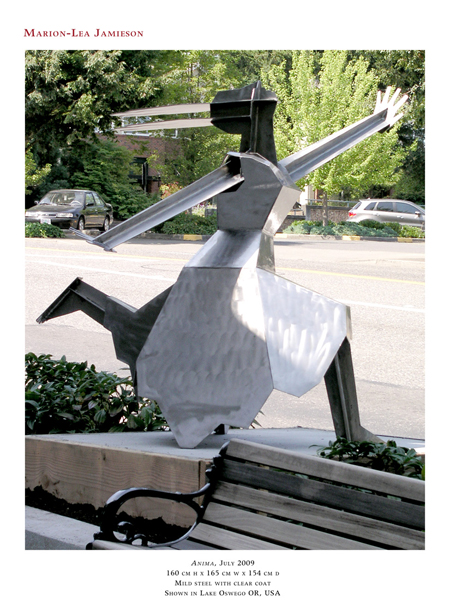
 Conundrum
II Conundrum
II
"This piece is very much a pregnant
form & is a throwback to the fascination I had with eggs while pregnant
myself. It's interesting though that it is the one abstract sculpture that
has never been accepted for exhibition. Still-Life is another of these,
but has somehow been more acceptable." (Marion Lea Jamieson in a letter
to AW)
|
|